Do you have a succulent growing tall, thin, and stretched-looking? Every succulent lover eventually encounters this. If this has happened to you, you may have noticed that the plant’s color is paler than it once was. It may be leaning over to one side, possibly dramatically so. This is an etiolatedA plant is etiolated (EE-tee-oh-late-ed) when it grows very ... succulent. The problem is succulents stretching due to insufficient sunlight, and it can really damage your plant. In extreme cases, it can lead to death. The good news is that this can be fixed, and you can get your succulent healthy and happy again! To recognize the issue and correct it, let’s take a close look at succulents, sunshine, and etiolation.
Succulents Stretching and Etiolated
In this Post We'll Cover:
{Please note, some links in this post may be affiliate links to sites that pay me a small commission if you click on the link and make a purchase. This commission is at absolutely no cost to you. I only recommend products and companies that I have worked with and truly love! ~Kat}
Etiolated Definition
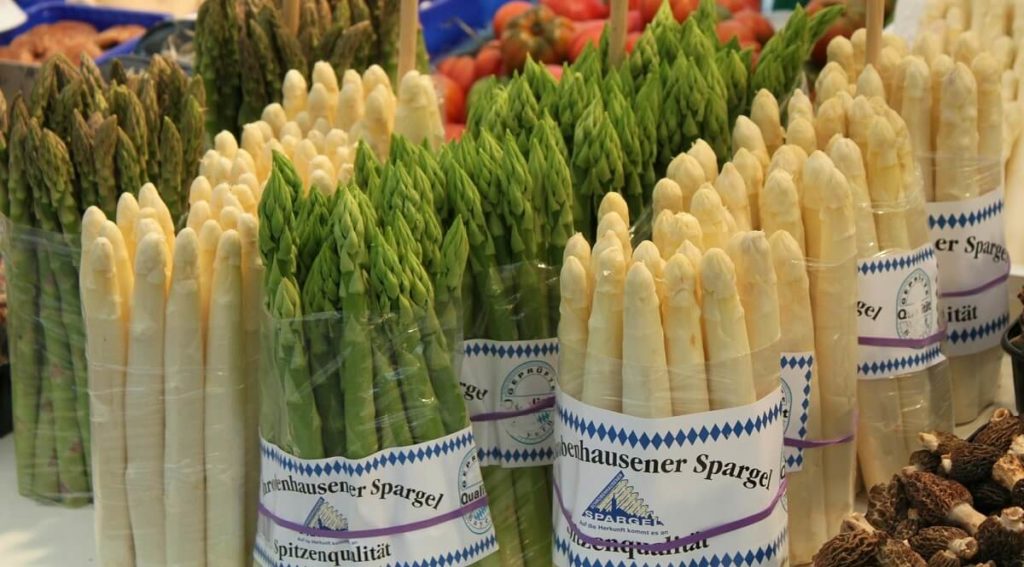
Etiolate (EE-tee-oh-late) means to grow a plant in a lack of sunlight, resulting in pale, weak growth, often thin and stretched. The Oxford English Dictionary defines etiolated as “(of a plant) pale and drawn out due to a lack of light.” Without light, plants fail to form chlorophyll, the substance that gives leaves their green color and that is the key element for absorbing energy from light. So, without light, plants don’t “green up” and are instead pale and weak. This condition is not always accidental. White asparagus and white celery are grown with all access to sunlight deliberately blocked to result in white spears and stalks. These are considered a delicacy – with prices to match. When it comes to succulents, there is no upside to etiolated plants. While it happens most often indoors, it can also happen outside.
Why Do Succulents Need Sun?
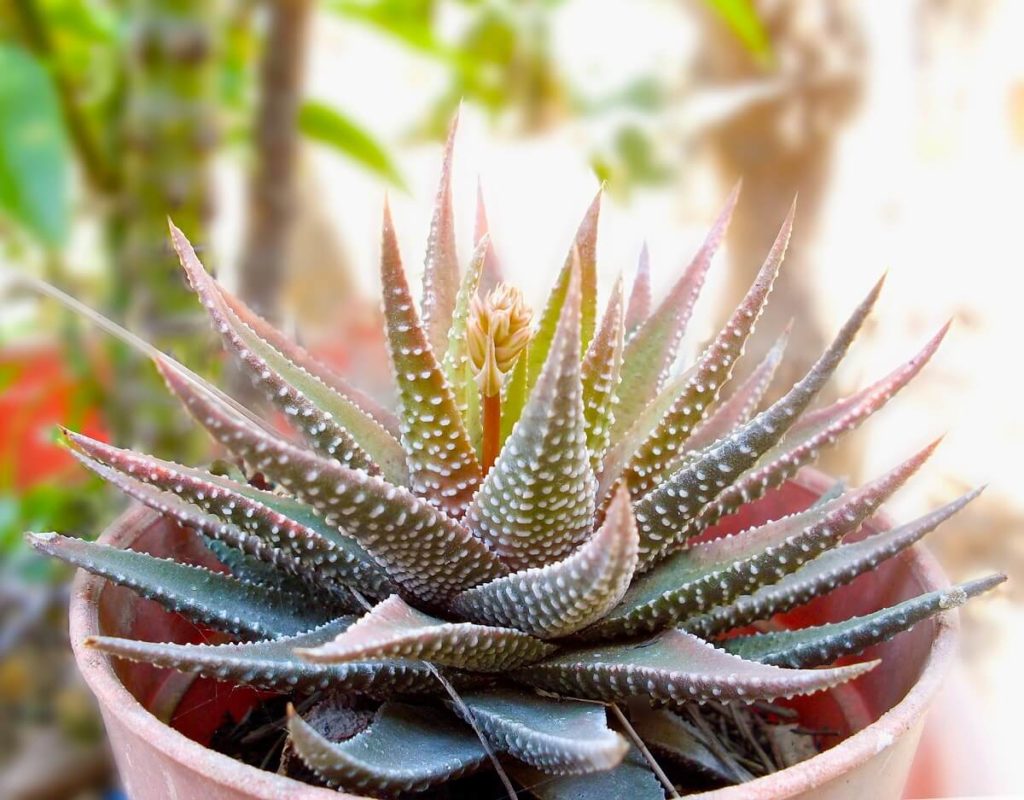
Succulents need sunlight for photosynthesisPhotosynthesis (FO-to-SIN-thuh-sis) is the process plants us... More. Photosynthesis is the process where a plant converts energy from sunlight, water, and carbon dioxide into energies it can use in the form of sugars and starches. Essentially, plants convert sunlight into carbohydrates or food. These carbohydrates fuel the plant’s growth, development of new leaves and roots, its flowering, and reproduction. This food fuels the plant’s entire life cycle. All life on earth is dependent upon photosynthesis. That’s a staggering statement, isn’t it? But it’s true. All plants need photosynthesis for food. And all animals, insects, and people rely on plants for food. Even carnivores eat animals that eat plants. And the foundation of this entire food chain is sunlight.
Succulents Stretching for Light
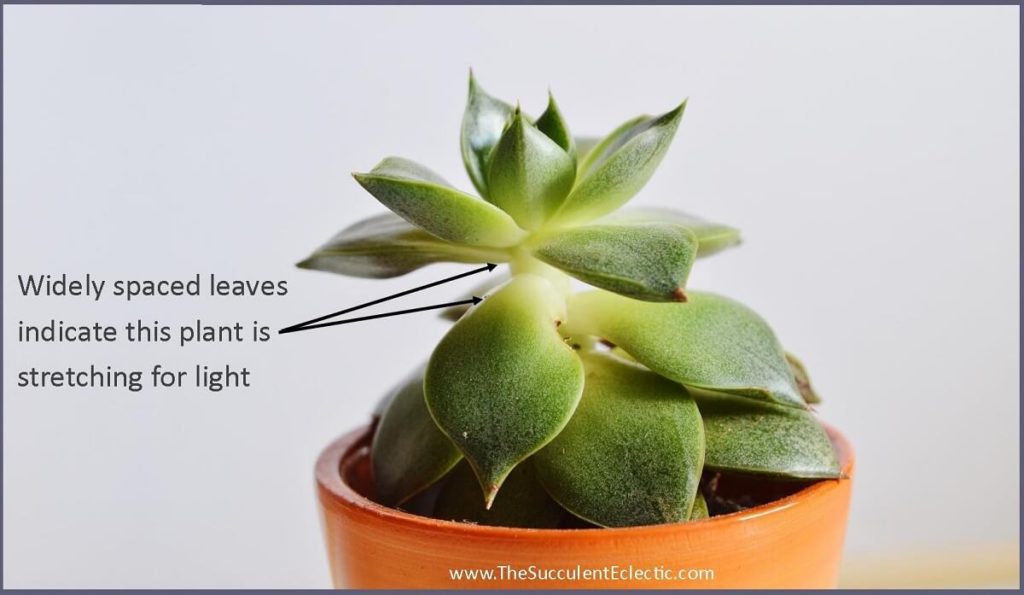
Given the vital importance sunlight is for a succulent, let’s look at what the plant does when it doesn’t get enough light. We tend to think of plants as static, immobile – even passive. But this is just how it seems. It’s certainly true that plants move much more slowly than most animals, but they are anything but passive. And they do move. While a plant cannot get up and walk into better lighting, it has developed adaptations to enable it to make the most of the light it does get, and to try to get more. A plant changes the orientation of its leaves to catch more light on the surface of the leaf. It will put on a quick flush of new growth, stretching to reach more light. In the picture above, you can see three specific changes this Echeveria is making in response to insufficient light:
- First, the lower leaves are pointing downward, not just drooping. This exposes the greatest surface area of each leaf to the light that is available, maximizing its ability to photosynthesize.
- Next, note how the plant leans to the left. It senses the greatest concentration of available light and bends toward it.
- Third, the stem is gaining height at a faster rate than new leaves can be developed. Large gaps are developing between the leaves. These gaps, too, expose each leaf to more light.
Etiolated Succulent Fenestraria
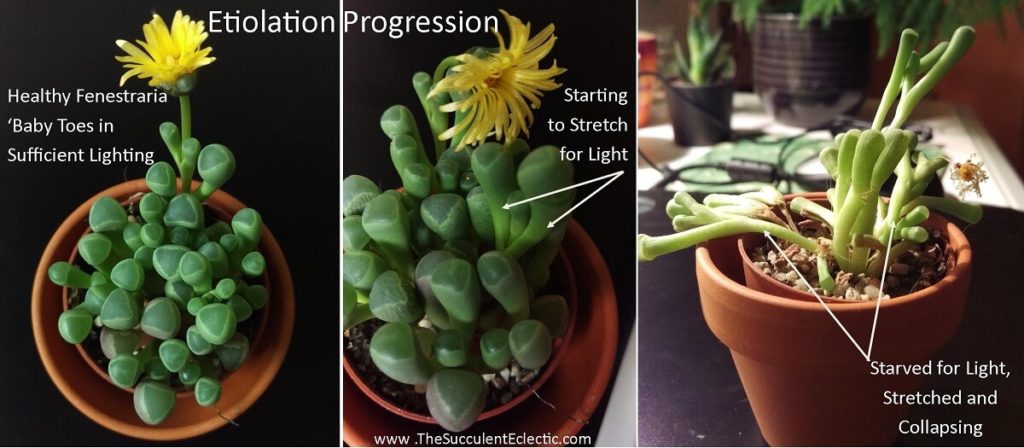
The Echeveria above is beginning to stretch for more light, but the plant is not unhealthy yet. It has lost some of its graceful form but is still vigorous and will respond well to an increase in light. But etiolation can be deadly. This photo progression of a Fenestraria baby toes plant demonstrates this all too well. On the left is the healthy, compact plant with its deep green leaves short and pudgy, like the little toes it is named for. Note that Fenestraria do not form a stem, just upright leaves connected to the root structure. Because this plant is in too little light, it begins to stretch, as shown in the middle shot. Eventually, the leaves become a pale color and so thin and stretched so tall they have collapsed and are no longer able to remain upright. This is inhibiting the plant’s ability to transfer water from its roots to the leaves. The plant is struggling to live.
Thank you, Nadine Eggenberger, for the photos to demonstrate this!
Etiolated Succulent Growing Tall
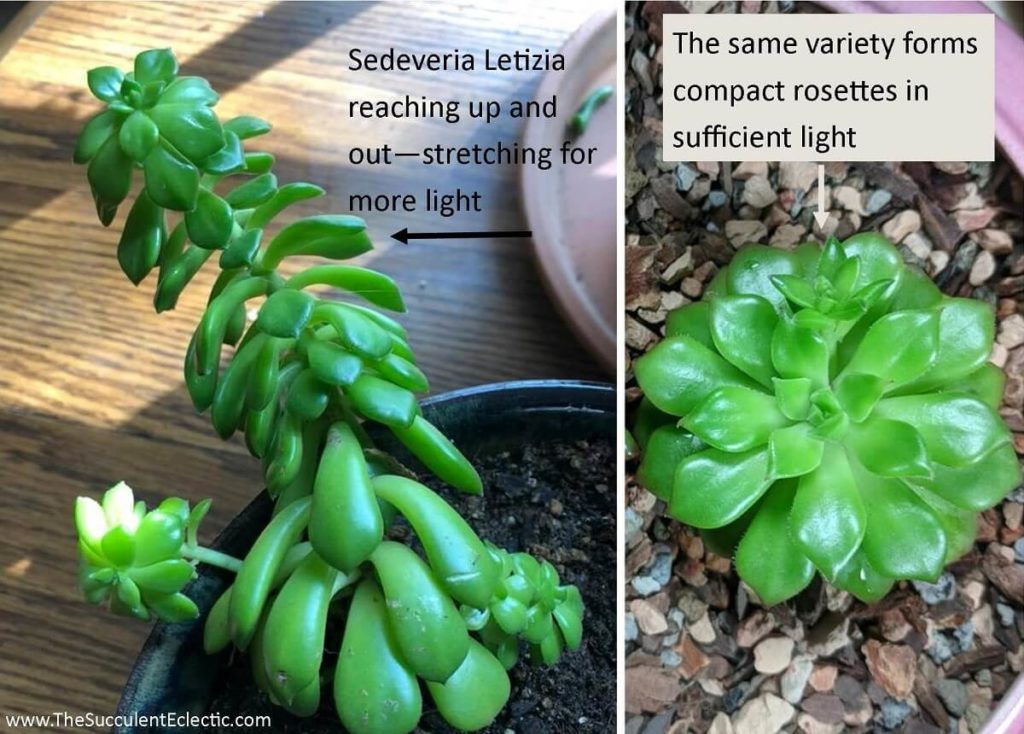
This Sedeveria Letizia on the left is a more typical example of a succulent growing tall and stretched. The leaves point down, and the stem is stretching tall, leaning way over to the side toward the light. Because its stem is growing faster than its leaves are developing, there are wide gaps between the leaves, exposing them to more light. The vivid green color tells us that this stretching is enabling the plant to reach enough light to continue to form abundant chlorophyll. It is still quite vigorous.
If the plant on the left is never moved into more light, eventually, the stem would break under the weight of its tall growth leaning to the side. You know what? In the wild, this is another adaptation to enable the plant to survive! You might see the development of aerial roots, indicating the plant expects to break. In nature, if this succulent stretches way off to the side, to the point of breaking, the stem would fall to the earth. And that stem would begin to sprout new roots, eventually forming a new and separate plant now anchored closer to the sunlight! My thanks to Emily Danielle Griffin and April Dailey for sharing their photos of Sedeveria Letizia!
Correcting Etiolated Succulent with Long Stem
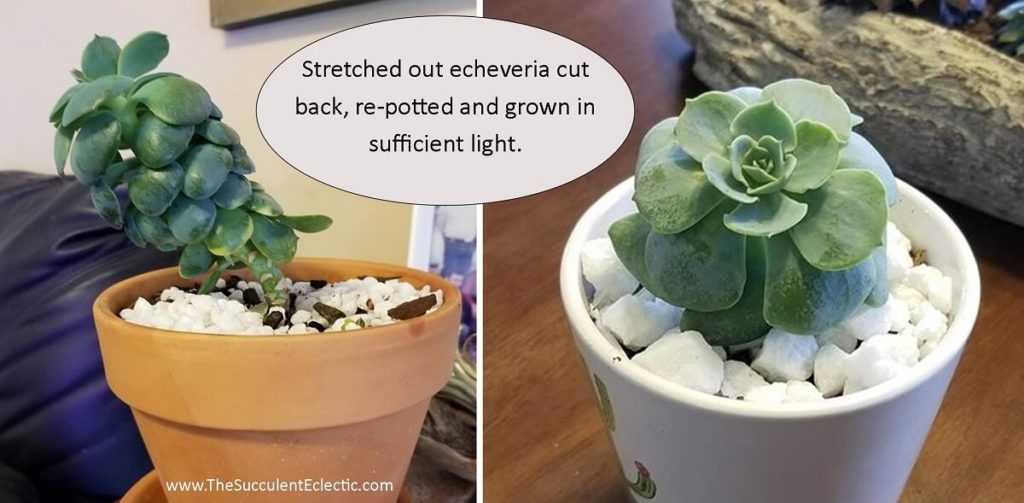
“As the twig is bent, so grows the tree” – Alexander Pope. But succulents are more resilient than trees. While it is true that a stretched stem will never shorten again, you can achieve a compact plant from an etiolated succulent. Simply cut the top rosette from the stem, remove the lower leaves, and replant it. Essentially, you are “beheading” the succulent! I know it sounds drastic, but just look at the beautiful results! This Echeveria ‘Blue Rose’ was a badly stretched, etiolated succulent. After cutting back the top and shortening the stem, it became a beautiful new plant! Click here for my in-depth guide to propagating your succulents from cuttings, including cutting back etiolated succulents.
Do Succulents Need Sun All Day Long?
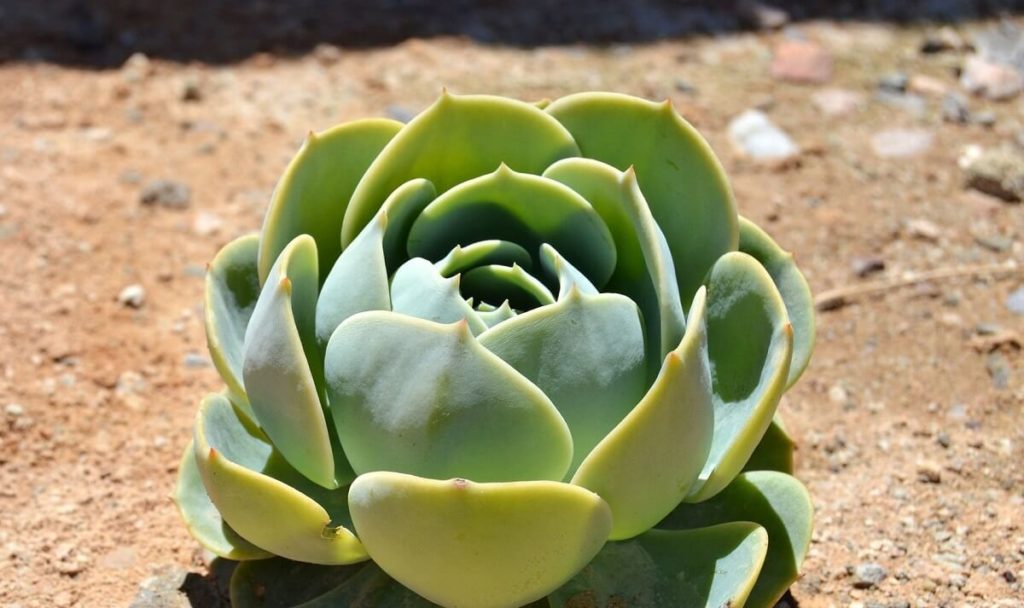
So, just how much light do succulents need? From all of the discussion above, you might wonder, do succulents need sun all day? Fortunately, they don’t. In fact, some succulents have adapted to growing in lower light conditions and are ideally suited to growing indoors. And while most succulents do need a lot of light, most cannot handle direct sun all day long. So, how do you know how much light to give them? Let the plant guide you.
Remember how succulents tip their leaves down in insufficient light to maximize the amount of leaf surface exposed to the sun? When you see your succulents doing this, move them into a bit more light right away rather than waiting for a long, gangly, stretched-out stem to form. And with this in mind, what do you think of this Echeveria, here? Not only are its leaves not pointing down, but it is looking pretty closed up, isn’t it? Do you see how this plant’s leaves are tilting to minimize the amount of leaf exposed to the light? In fact, each leaf is shading the next. This rosette is more closed than Echeveria typically are. This tells us that the plant is getting a lot of light. Perhaps not dangerously too much, but the plant is using its adaptations to conserve water rather than to maximize photosynthesis. So, this plant could certainly handle less sunlight.
Adjusting Succulents to More Light
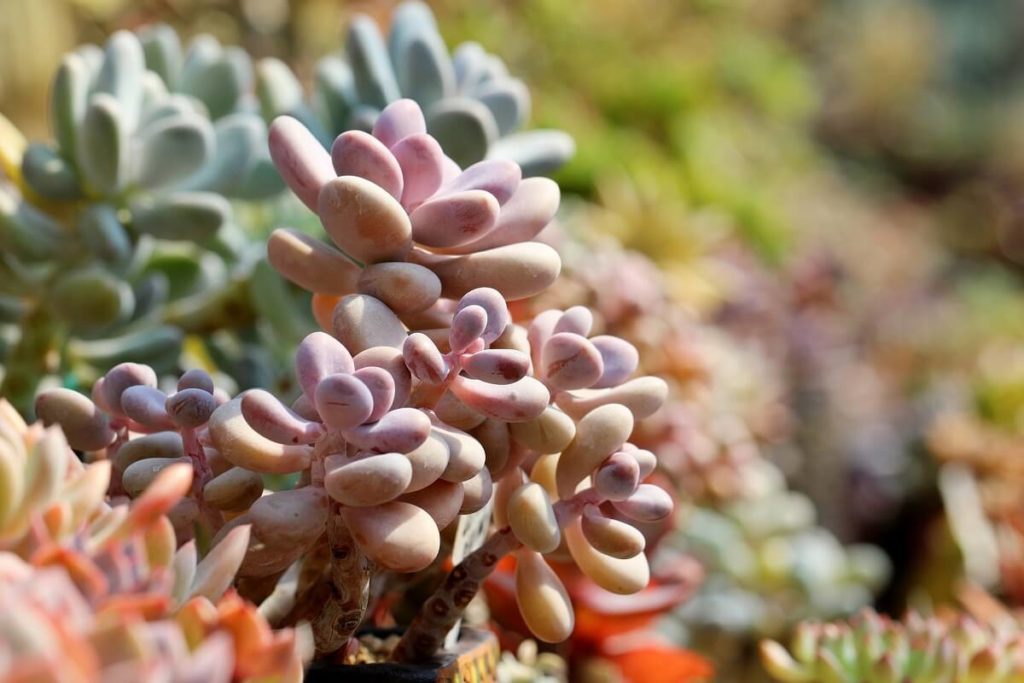
Acclimate succulents to more light gradually so as to avoid sunburn. Add more light by just 30 minutes per day, every third day. Be sure to watch the plant carefully for signs of stress. As long as the leaves are tipped down, continue to add more light on this gradual plan. Too much direct light can cause the leaves to sunburn. This can happen from adding too much light too quickly before the plant is able to adapt to it. Think of when you start to develop a tan. You don’t spend the first day in direct sun for 6 hours! A half-hour on the first day might be a bit much, even though, in time, you will be able to handle much more. The same is true for your succulent.
Etiolated Succulent Frequently Asked Questions (FAQs)
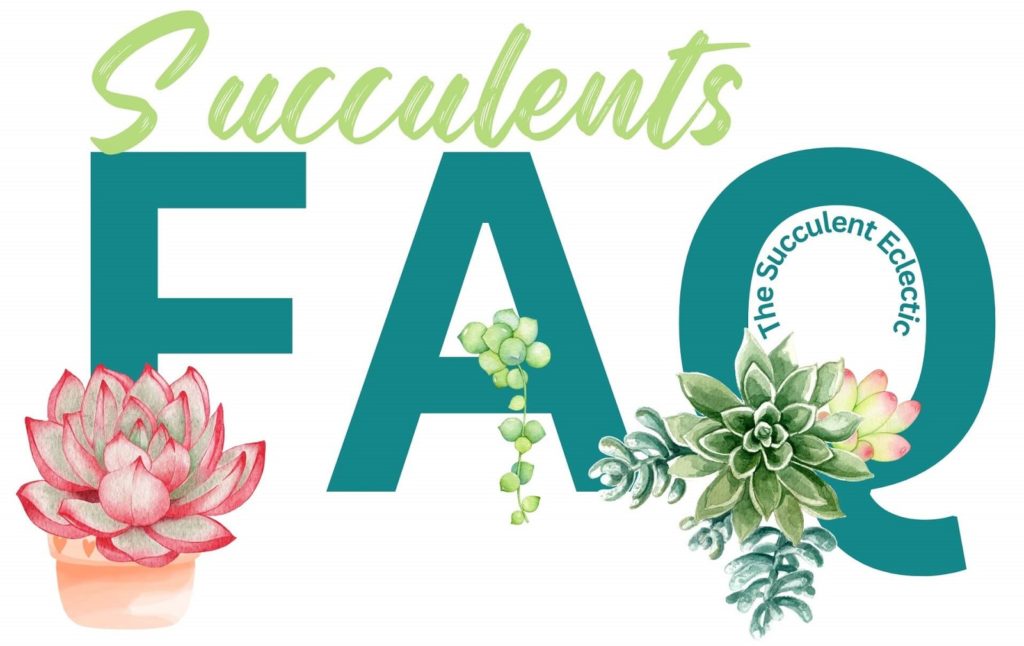
Why is my succulent growing tall?
Succulents stretch and grow very tall when they need more sunlight. They may also lean to one side as they strive to reach the closest source of light. When you see a succulent stretching with more space between the leaves, it is a sign that it should be relocated to a spot where it can get the light it needs.
What happens if you cut the top off a succulent?
For many succulent varieties, cutting the top off gives you a chance at two plants. The rooted base will continue to grow, and the top part can develop roots, too. This is often the best way to correct an etiolated succulent growing tall and stretched out.
Can etiolated plants recover?
When an etiolated plant gets more light, it cannot “un-stretch.” All new growth that develops in sufficient sunshine will be nicely compact, but the stretched growth remains stretched. When succulents grow too tall and stretched, they can be cut back and re-rooted so that the new plants grow in their compact form. Other plants are often harder to propagate.
What happens when succulents get leggy?
When succulents get leggy, it is a result of stretching for more light. In most cases, the stretched succulent may look unsightly, but it remains healthy. In some severe cases, however, etiolation (stretching for more light) can be deadly to succulents.
When You Have a Succulent Growing Tall
There you have it! You now know why your succulent is growing so tall. You can diagnose an etiolated succulent, and you know how to correct it! 🙂 If you have any questions, please take a moment and leave a comment. I will get right back to you!
Because life is just better with succulents!

P.S. For my FREE course, 7 Steps to Succulent Success, please subscribe! Thanks so much!
P.P.S. Why not join my Facebook Group for succulent-lovers? We talk succulent care, propagation, identification, and design. It’s a warm and welcoming group that would love to meet you!
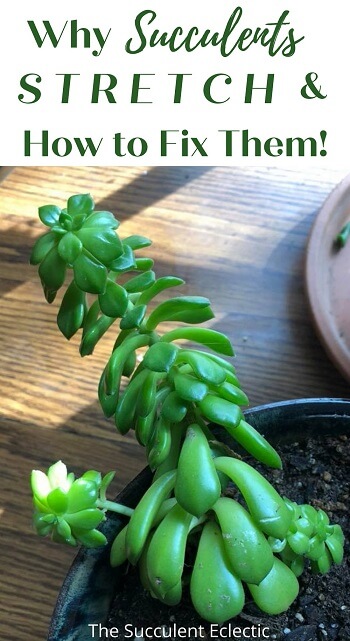
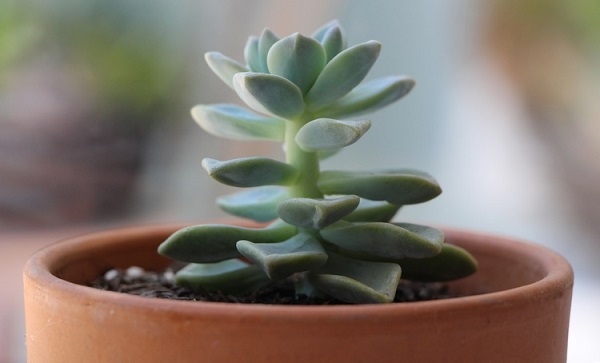


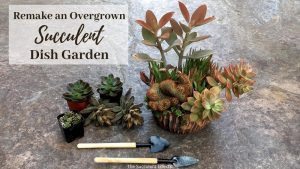

Your link above for the guide propagation of succulents is broken…
Thanks SO much, Blue, for letting me know!
I have now fixed the link to propagating succulents from stem cuttings.
I appreciate your help! 🙂
~Kat